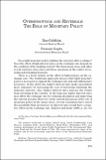| dc.contributor.author | Goldfajn, Ilan | |
| dc.contributor.author | Gupta, Poonam | |
| dc.date.accessioned | 2019-11-01T00:01:33Z | |
| dc.date.available | 2019-11-01T00:01:33Z | |
| dc.date.issued | 2002 | |
| dc.identifier.isbn | 956-7421-072 | |
| dc.identifier.uri | https://hdl.handle.net/20.500.12580/3644 | |
| dc.description | Does tight monetary policy stabilize the currency after a collapse?. Does the effect of high interest rates on the exchange rate depend on the condition of the banking system? The East Asian crises and other recent currency crises have put these questions at the center of economic policymaking decisions. | |
| dc.format | .pdf | |
| dc.format.extent | Sección o Parte de un Documento | |
| dc.format.medium | p. 279-302 | |
| dc.language.iso | eng | |
| dc.publisher | Banco Central de Chile | |
| dc.relation.ispartof | Serieson Central Banking, Analysis, and Economic Policies, no. 3 | |
| dc.rights | Attribution-NonCommercial-NoDerivs 3.0 Chile | * |
| dc.rights.uri | http://creativecommons.org/licenses/by-nc-nd/3.0/cl/ | * |
| dc.subject | POLÍTICA MONETARIA | es_ES |
| dc.subject | TASAS DE INTERÉS | es_ES |
| dc.subject | TIPO DE CAMBIO | es_ES |
| dc.subject | CRISIS FINANCIERA | es_ES |
| dc.title | Overshootings and reversals: the role of monetary policy | |
| dc.type.doc | Artículo | |
| dc.file.name | BCCh-sbc-v03-p279_302 | |


